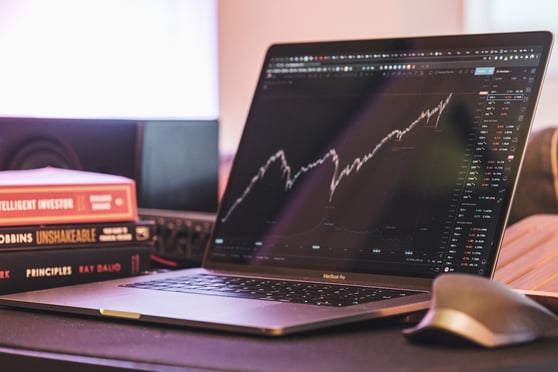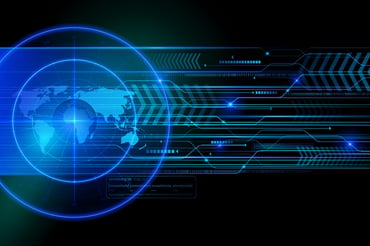This is the seventh blog post in HYPE's series on the ten most often-asked questions about strategic foresight. While the sixth post offered insights on how foresight can inform business models, people, and organization development, this post looks at foresight's support for innovation management in identifying future market needs and potential solutions for them.
Innovation can be described as a novel solution to a market need. The market need can be created or emerge based on changes in the demographics, regulation, or technology, to name a few commonly known drivers behind it. Strategic foresight can support anticipation of future values, behaviors, expectations, and needs of customers that are not yet in the mainstream. Also, foresight can help in identifying markets that do not yet exist. Just as with customers, foresight can bring insights into the values, behaviors, expectations, and needs of the relevant stakeholders. Identifying future market needs and potential solutions for them and the business opportunities that follow is especially well-suited in collaboration and dialogue with customers and partners. In a B2B setting, this means creating a common strategic agenda for innovation to satisfy future market needs.
Other than anticipating future market needs and drivers impacting the demand, innovation, and R&D managers utilize foresight practices for filling in and managing innovation portfolios, in risk management to identify potential threats to current offerings and competitive advantages, and overall, to challenge the status quo before the competition will. For example, in the food industry, meat-producing companies that have captured the trend of Flexitarian and have expanded to plant-based products have been able to grow sustainably through the exploration of new business opportunities. Another example is the Danish multinational power company Orsted, which has transformed its generation mix and decarbonized its business model well ahead of the competition from 85% conventional and 15% renewable to 85% renewable and 15% conventional. The payback is obvious for the companies that identify and solve market needs earlier than others – at stake is a competitive advantage and the ability to stay ahead of the game.
Market needs and new business and innovation opportunities arise across three horizons
Various foresight tools – horizon scanning, trend identification, system maps for causal relationships, scenarios, etc. – aid in identifying future market needs and potential solutions across the three horizons. In Horizon 1, innovation and R&D managers utilize foresight to continuously innovate on a company's existing business model and core capabilities. Horizon 1 market needs and innovations are usually visible, and largely understood, and issues to which companies are already responding. In Horizon 2, companies seek new market needs and innovations with the foresight to extend a company's business model and core capabilities. Horizon 2 market needs and innovations are usually less well characterized and often less urgent: companies may prefer to wait and see and grow the existing business even though aware of the Horizon 2 market needs and innovation opportunities. In Horizon 3, innovation and R&D managers use foresight to build new businesses and capabilities "to take or respond to disruptive opportunities or counter disruption." Often, a delivery time has been assigned to the horizons, but today, the three horizons are no longer bound by time. As Steve Blank succinctly notes, "Disruptive Horizon 3 ideas can be delivered as fast as ideas for Horizon 1 in the existing product line". Also, more and more companies are spreading their innovation investments evenly across the three horizons compared to a decade ago when the split of investments was 70% to incremental innovations (H1), 20% to substantial (H2), and 10% to transformational (H3). Hence, the importance of foresight and anticipation cannot be stressed enough.
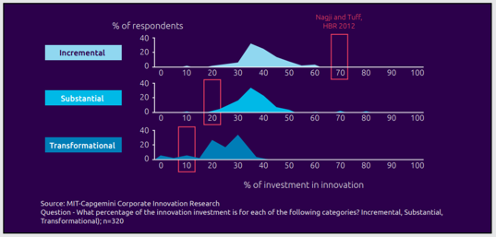
Practical tips for the anticipation of future market needs
In our earlier blogs on strategic foresight, we have covered valuable information for the anticipation of future market needs:
Choose the focus by defining the "the future of" you want to learn about and why:
For example, a company in the food production market could ponder about the future of food or eating and subsequently about the changes in demographics and values behind consumers' food choices, urbanization, climate change, regulatory changes, and technological advancements throughout the value chain.
Adapt a wide enough lens and go beyond the strong signals:
The first principle encourages looking beyond the changes in a company's immediate playing field, industry, and role in the value chain. Your business, customers, customers' customers, suppliers, and partners are the viewpoints through which depth is brought to foresight. The second principle challenges to pay attention to the fringes – to the weak signals and wild cards in addition to the trends and megatrends. Often, foresight focuses too narrowly on strong signals – to the knowns, such as trends and megatrends – and their implications, which seldom offer privileged insights to innovation and R&D managers.
Brainstorm the future of your market together with customers and partners:
Talking about the future – interpretations of trends or alternative views of the future – with actors outside of your organization helps test and enrich the interpretations and implications of foresight. You can invite customers, customers' customers, non-customers, suppliers, suppliers' suppliers, and partners to participate in the discussions about the future. All players in your value chain or ecosystem can bring additional viewpoints to how they see trends and scenarios develop, market needs arise, and the business potential of possible solutions. The most valuable discussions have taken place in workshops where customers and partners from different industries and markets have had the opportunity to familiarize themselves with the interpretations and scenario descriptions beforehand with the explicit assignment to come and enrich and challenge the views of the market's future.
Identification of future market needs and innovation opportunities utilizes both customer and foresight research methods
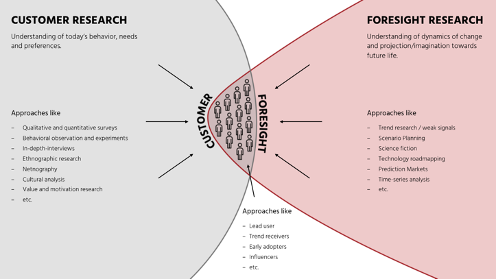
Eric Eller, Rupert Hofmann, and Jan Oliver Schwarz brilliantly note that "even if we had a clear picture of future technological, political and economic developments, the question of how people will react to future realities would still be a mystery." Hence, approaches such as lead users, trend receivers, early adopters, and the like are needed to turn foresight into actionable insight for innovation management. Lead users, influencers, and alike are all "agents of the new" who can help examine how the customer of the future might want to live and propose novel solutions.
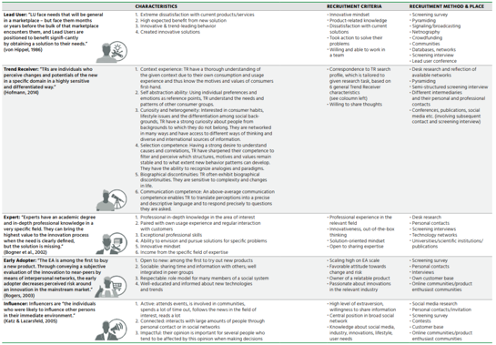
What tools do you have in your toolbox for foresight-driven innovation management?
As an SVP of Strategy at Lindström, I have identified that our tool called Lindström Lounge Innovation Workshops is a wonderful way to discuss future trends with our customers. Our customers choose trends that they see as relevant or interesting for this business, and together we analyze their implications. Our customers and we can then utilize business development insights to become industry forerunners.
What tools do you have in your toolbox for innovation management that puts you ahead of trends and competition?





